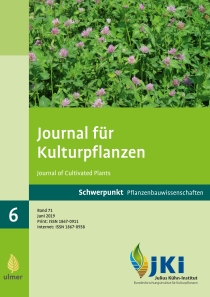Mineral P and K fertilization effect on crop yield response as a function of soil nutrient supply under the cultivation conditions of organic farming in Germany
DOI:
https://doi.org/10.5073/JfK.2019.06.02Keywords:
organic farming, crop yield, P- and K basic fertilization, soil analysisAbstract
According to conventional farming knowledge from basal nutrient experiments, statistical relations were found between topsoil plant-available nutrient concentrations and crop yield differences received from additional fertilization which are especially well-suited to establishing fertilization measurement procedures, when as many trial results and sites as possible in the data analysis where included. However, the findings obtained are dependent on the yield level of the cropping system. Therefore, in this paper all available field trials conducted under organic farming conditions were collected with regard to mineral phosphorus (P, soft rock phosphate, Thomas phosphate) and potassium (K, natural potash salts, potassium sulfate) fertilizer application.
Within the time period 1993–2016 regression and boxplot graphical and tabular analyses could be used to analyze multi-year trial results comprising 21 sites and 243 P variants and 30 sites and 201 K variants from a total of 9 federal German states. The relations between the available P and K nutrients (extraction with diluted lactate solutions, CAL, DL) and the relative crop yield differences between standard and fertilizer variants (0–100 kg P/ha/a, 0–664 kg K/ha/a) were described as quantitatively as possible. Subject to increasing soil content of P (0.8–12.3 mg P/100 g) and K (2.1–29.0 mg K/100 g), the declining yield increase from nutrient deficit up to yield maximum was clearly visible for both nutrient results.
The yield effect of P fertilizers was different at high soil pH values. Contrary to the findings of the P increase trials, distinct interactions between soil type as well as the cultivated crop species and the yield effects were found in the range of low K concentration. On plots with insufficient soil K content fertilization led to higher yield effects on heavy soils (L–T) than on light soils (S–sL). In order of precedence, clover and alfalfa grass mixtures, row crops (potato, maize, field vegetables) and especially grain legumes (field bean, pea, lupine) reacted much more sensitively than cereal crops.
According to the nutrient-availability classification system of the VDLUFA, aggregation of the crop yield results into groups of differently available soil nutrient content enabled nutrient ranges to be identified in which only marginal or no mean yield effects were achieved with additional fertilizer application. These optimal nutrient values of 2.5–4.5 mg P/100 g and 6.6–10.0 mg K/100 g soil are located on a markedly lower level compared to estimated values of conventional cultivation systems. Subject to the high range of the individual results within very low soil nutrient contents, mean yield increase of 9% appeared after P and of 12% after K fertilization. These experimentally established groups for classifying soil nutrient content can be used to further development work on fertilizer requirement methods in organic farming systems.
Downloads
Published
Issue
Section
License
The content of the journal is licensed under the Creative Commons Attribution 4.0 License. Any user is free to share and adapt (remix, transform, build upon) the content as long as the original publication is attributed (authors, title, year, journal, issue, pages).
The copyright of the published work remains with the authors. The authors grant the Journal of Cultivated Plants, the Julius Kühn-Institut and the OpenAgrar repository the non-exclusive right to distribute and exploit the work.







